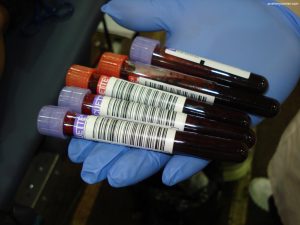by Kevin Shanks, M.S., D-ABFT-FT
Postmortem redistribution (PMR) is the phenomenon that occurs in blood drug concentrations after death as drug from anatomic sites of high drug concentration (e.g. organs such as the liver, lungs, and heart (myocardium)) is released to sites of lower drug concentration (e.g. the blood). This release may falsely elevate the drug concentration in blood surrounding the organs or from the central cavity.

Blood collected in test tubes for analysis.
Test Tubes with Blood” by biologycorner is licensed under CC BY-NC 2.0.
Substances that are alkaline (pH > 7.0), lipophilic, and have volumes of distribution (Vd) greater than 3 L/kg are more likely to undergo PMR. These substances include many commonly detected drugs such as tricyclic antidepressants (e.g. amitriptyline, nortriptyline), amphetamines (e.g. methamphetamine, amphetamine), and opioids (e.g. fentanyl, oxycodone).
The exact mechanism of PMR has not yet been identified, but changes in pH and protein structure after death are thought to also play a role in the phenomenon. Because of this phenomenon, the preferred anatomical sites of blood collection for toxicological analyses are peripheral sites such as the iliac or femoral veins. The site of blood collection is but one variable in the occurrence of PMR. Other factors influencing PMR include body storage temperature (the higher the temperature, the greater the potential for concentration change), the time between death and specimen collection (a longer lapsed time gives more potential for changes), the position of the body when found (blood may drain from centrally located sites to peripherally located sites), and medical intervention (stomach contents may be aspirated or blood may move from central to peripheral sites; drug may be released from traumatized tissue into blood).
Even as it has been studied for decades, PMR is a complex process and is still not fully understood, but the aforementioned factors are just some variables to be considered when interpreting toxicology’s role in a medical-legal death investigation.
If you have any questions or concerns regarding PMR’s role in a postmortem toxicology case, please reach out to our Axis Forensic Toxicology subject matter experts at [email protected].
References
- Barnhart FE, Bonnell HJ, Rossum KM. Postmortem Drug Redistribution. Forensic Sci Rev. 2001. Jul;13(2):101-129.
- Pelissier-Alicot AL, Gaulier JM, Champsaur P, Marquet P. Mechanisms Underlying Postmortem Redistribution of Drugs: A Review. J Anal Toxicol. 2003 Nov-Dec;27(8):533-544.
- Yarema MC, Becker CE. Key Concepts in Postmortem Drug Redistribution. Clin Toxicol (Phila). 2005;43(4):235-241.
- Postmortem Redistribution of Drugs. Principles of Forensic Toxicology. Fifth Edition. Fred S. Apple, Barry S. Levine, Sarah Kerrigan. Springer Nature Switzerland AG. 2020. 595-602.
